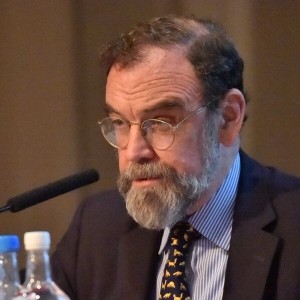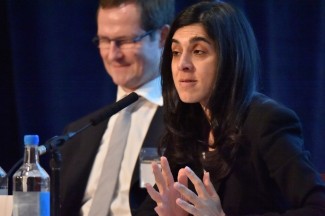Laws and regulators need get up to speed with high-frequency trading technology, panelists say

Edward F. Greene of Cleary Gottlieb in New York. Photo by Simon Apps.
The world of insider trading and the laws needed to prosecute those illegal trades continues to evolve as new issues and technologies used for trading emerge, attorneys said at an ABA panel discussion Friday.
The fast-changing landscape is best illustrated by the recent case of Navinder Singh Sarao, the British man who currently is awaiting extradition to the U.S. for his alleged role in the May 6, 2010 “flash crash,” in which U.S. stock markets made a dramatic plunge in a matter of minutes. The criminal complaint (PDF) filed against Sarao said he used an automated trading program of high-frequency trades to manipulate one of the futures markets on the Chicago Mercantile Exchange.
High-frequency trading employs technology and algorithms to trade securities rapidly, often in seconds or fractions of seconds.
But the high level of sophistication to complete high-frequency trading means it is difficult for regulators around the world to catch those traders who are not operating legally, said Peter Castellon, a partner at Proskauer Rose in London.
“That’s what’s evil about high-frequency trading, and it’s very hard to catch because of the sophistication of the algorithms,” he said.
One of the interesting issues that has arisen out of high-frequency trading is the co-location of computer servers that give traders an advantage, said Edward F. Greene, senior counsel at Cleary Gottlieb and a senior research scholar and lecturer-in-law at Columbia Law School. “When you can trade in milliseconds—and that’s what we’re talking about, milliseconds—that type of advantage can be profitable.”
The comments were made at the Friday afternoon panel, “Global Trends on Regulation of Insider Trading and Market Abuse: Europe, U.S. and Asia” at the ABA London Sessions. Panelists explored nine hypothetical cases in which insider trading may have occurred and explained how the law would differ in the U.S., the U.K. and in Europe. The program was sponsored by the ABA Section of International Law.
Americans also can get caught up in the differing laws of the United States and the United Kingdom for insider trading. This happened in 2012 to hedge fund manager David Einhorn of Greenlight Capital, who was fined 7.2 million pounds ($11.2 million) by the U.K. Financial Services Authority.

Nilufer von Bismarck of Slaughter and May in London. Photo by Simon Apps.
The FSA said that Einhorn participated in a phone call when he was told that Punch Taverns would soon be issuing new equity, a move that would decrease the value the stock. Einhorn then reduced his holdings in the company prior to the announcement of the new equity sale, which saved his hedge fund 5.8 million pounds.
The FSA said this constituted insider trading as the information wasn’t available to the public, but Einhorn argued that he did not think it was insider information. “It did cause some significant outrage in the U.S. at the time,” said Nilufer von Bismarck, a partner at Slaughter and May in London.
The panel discussion took place Friday as part of the ABA London Sessions, which are being held to commemorate the 800th anniversary of the sealing of the Magna Carta.
• See what people are saying about the events on Twitter at #MagnaCarta800th and #ABALondon2015, and follow along with our full coverage of the ABA London Sessions.



